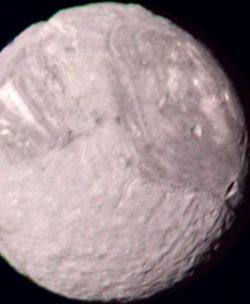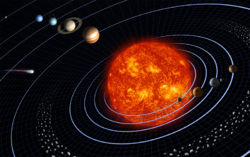Miranda
 From Conservapedia
From Conservapedia | Miranda | |
|---|---|
 True-color composite image of Miranda by Voyager 2 | |
| Date of discovery | February 16, 1948[1] |
| Name of discoverer | Gerard P. Kuiper[1][2][3] |
| Name origin | Female lead in William Shakespeare's play The Tempest[1][3] |
| Orbital characteristics | |
| Primary | Uranus |
| Order from primary | 14 |
| Periuranion | 129,450 km[4] |
| Apuranion | 130,150 km[4] |
| Semi-major axis | 129,800 km[5] |
| Orbital eccentricity | 0.0027[5] |
| Sidereal month | 1.413 da[5] |
| Inclination | 4.22°[5] to Uranus's equator |
| Rotational characteristics | |
| Sidereal day | 1.413 da[5] |
| Rotational speed | 1.021 m/s[4] |
| Axial tilt | 0° |
| Physical characteristics | |
| Mass | 6.59 * 1019 kg (0.09% Moon)[5] |
| Density | 1,200 kg/m³[5] |
| Mean radius | 234.2 km[5] |
| Equatorial radius | 240 km[5] |
| Polar radius | 232.9 km[5] |
| Surface gravity | 0.0802 m/s² |
| Escape speed | 0.194 km/s |
| Surface area | 689,261 km²[4] |
| Maximum temperature | 86 K[2] |
| Composition | Ice and rock |
| Color | Light purple-gray |
| Albedo | 0.27[5] |
Contents
Discovery[edit]
Gerard P. Kuiper discovered Miranda in 1948. He rejected at once naming the satellite after a son of Uranus, because earlier astronomers had already used Uranus' sons as names for Saturn's moons. He therefore followed the lead of Lassel and Herschel[1] and named Miranda after a character in one of the plays of William Shakespeare.[3]
When Voyager 2 flew by Uranus in 1986, Miranda was the closest moon to Voyager's flight path, and was therefore the one that Voyager 2 studied most closely. The Voyager team originally had not planned a mission to so small a moon, but could do nothing else; Voyager needed to make a precise hyperbolic pass at Uranus in order to steer toward Neptune, and Miranda happened to lie along the way. Yet in the end the Voyager scientists were grateful for the opportunity to study this remarkable object.[6][7]
Orbital characteristics[edit]
Miranda's orbit is one of the least eccentric of those of the five "major moons" of Uranus. While some of Uranus' moons have orbits that are less eccentric by an order of magnitude, Umbriel's orbit is significantly more eccentric than that of Miranda, and many of the other satellites have orbits more eccentric still.
More significantly, Miranda's orbit is inclined with respect to Uranus' equator by more than four degrees. This is the highest inclination among the orbits of the "major moons," although some of Uranus' moons have orbits that are inclined by more than forty-five degrees.
Rotational characteristics[edit]
Miranda orbits Uranus once every 33 hours, and is tidally locked to Uranus. This tidal locking does not allow Miranda to have a significant axial tilt.
Physical characteristics[edit]
Miranda's mass is less than 0.09% of the mass of Earth's Moon. At only 1200 kilograms per cubic meter, it is also one of the least dense, less dense even than the sun. Its density is closest to that of water, and so Miranda is believed to be composed mainly of ice with some rock.
Miranda has the most striking landscape of any spheroidal celestial body other than the earth. Its largest surface features are extremely striking in their bizarre variety and stark relief, almost as if Miranda were an object that someone pieced together out of scrap metal.[8] Twenty-kilometer canyons[6][7] give way to cratered regions[8] and other regions nearly devoid of craters. The mixture of geologically "old" and "young" regions is quite puzzling.[6]
Difficulties for uniformitarian theories[edit]
The geological activity required to produce Miranda's striking mix of surface features defies explanation.[9]
Shortly after the Voyager 2 flyby, astronomers proposed that Miranda was shattered five times by collisions and then reassembled by mutual gravitational attraction.[6][7][8][9] But such a small moon would not be likely to survive even one collision, much less five. This theory is now out of favor.
The current favored theory is that Miranda was once in a 1:3 orbital resonance with Umbriel, and then escaped that resonance. While Miranda was resonating with Umbriel, its orbit gained in eccentricity and thus subjected it to tidal heating. To support that theory, astronomers point out that Miranda's orbit, inclined 4.22° from Uranus' equator, is more severely inclined than that of any other satellite in the Uranian system.[10][11][12] Some believe that this tidal heating caused an upwelling of subsurface ice that produced some of the most pronounced surface features.[13]
But this begs the question of how orbital resonances form, or how a satellite, once in such a resonance, would escape it. More to the point, however, is that the orbit of Miranda is not the most strikingly eccentric orbit in the Uranian system. Even among the major moons, that distinction belongs to Umbriel, not Miranda.
Gallery[edit]
References[edit]
- ↑ 1.0 1.1 1.2 1.3 "Gazetteer of Planetary Nomenclature: Planetary Body Names and Discoverers." US Geological Survey, Jennifer Blue, ed. March 31, 2008. Accessed April 17, 2008.
- ↑ 2.0 2.1 Hamilton, Calvin J. "Entry for 'Miranda, A Moon of Uranus'." Views of the Solar System, 2007. Accessed April 28, 2008.
- ↑ 3.0 3.1 3.2 Kuiper, Gerard P. "The Fifth Satellite of Uranus." Publications of the Astronomical Society of the Pacific, 61(360):129, June 1946. Accessed April 28, 2008.
- ↑ 4.0 4.1 4.2 4.3 Calculated
- ↑ 5.00 5.01 5.02 5.03 5.04 5.05 5.06 5.07 5.08 5.09 5.10 "HORIZONS on Miranda." Solar System Dynamics, Jet Propulsion Laboratory, NASA, August 2, 2007. Accessed April 28, 2008.
- ↑ 6.0 6.1 6.2 6.3 Harvey, Samantha. "Uranus: Moons: Miranda." Our Solar System, NASA, February 23, 2007. Accessed April 28, 2008.
- ↑ 7.0 7.1 7.2 Arnett, Bill. "Miranda." The
Nine8 Planets, December 15, 2004. Accessed April 28, 2008. - ↑ 8.0 8.1 8.2 "Uranus' Moon Miranda." The Planetary Society. Accessed April 28, 2008.
- ↑ 9.0 9.1 Chaikin, Andrew. "Birth of Uranus' Provocative Moon Still Puzzles Scientists." <http://www.space.com/> October 16, 2001. Accessed April 28, 2008.
- ↑ Tittemore, William C., and Wisdom, Jack. "Tidal evolution of the Uranian satellites II. An explanation of the anomalously high orbital inclination of Miranda." Icarus 78(1):63-89, March 1989. Accessed April 28, 2008. <doi:10.1016/0019-1035(89)90070-5>
- ↑ Tittemore, William C., and Wisdom, Jack. "Tidal evolution of the Uranian satellites III. Evolution through the Miranda-Umbriel 3:1, Miranda-Ariel 5:3, and Ariel-Umbriel 2:1 mean-motion commensurabilities." Icarus 85(2):394-443, June 1990. Accessed April 28, 2003. <doi:10.1016/0019-1035(90)90125-S>
- ↑ Malhotra, Renu, and Dermott, Stanley F. "The role of secondary resonances in the orbital history of Miranda." Icarus 85(2):444-480, June 1990. <doi:10.1016/0019-1035(90)90126-T>
- ↑ Pappalardo, R. T., S. J. Reynolds, and R. Greeley (1997), Extensional tilt blocks on Miranda: Evidence for an upwelling origin of Arden Corona, J. Geophys. Res., 102(E6), 13,369–13,379.
| |||||||||||||||||||||||||||||
↧ Download as ZWI file | Last modified: 02/22/2023 02:18:58 | 19 views
☰ Source: https://www.conservapedia.com/Miranda | License: CC BY-SA 3.0
 ZWI signed:
ZWI signed:


 KSF
KSF